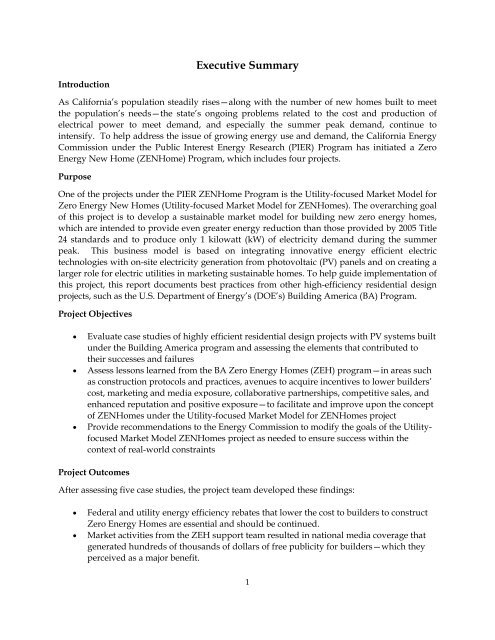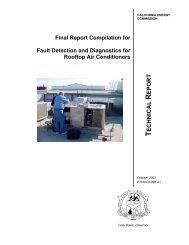design process study for the demonstration homes - Architectural ...
design process study for the demonstration homes - Architectural ...
design process study for the demonstration homes - Architectural ...
Create successful ePaper yourself
Turn your PDF publications into a flip-book with our unique Google optimized e-Paper software.
Introduction<br />
Executive Summary<br />
As Cali<strong>for</strong>nia’s population steadily rises—along with <strong>the</strong> number of new <strong>homes</strong> built to meet<br />
<strong>the</strong> population’s needs—<strong>the</strong> state’s ongoing problems related to <strong>the</strong> cost and production of<br />
electrical power to meet demand, and especially <strong>the</strong> summer peak demand, continue to<br />
intensify. To help address <strong>the</strong> issue of growing energy use and demand, <strong>the</strong> Cali<strong>for</strong>nia Energy<br />
Commission under <strong>the</strong> Public Interest Energy Research (PIER) Program has initiated a Zero<br />
Energy New Home (ZENHome) Program, which includes four projects.<br />
Purpose<br />
One of <strong>the</strong> projects under <strong>the</strong> PIER ZENHome Program is <strong>the</strong> Utility-focused Market Model <strong>for</strong><br />
Zero Energy New Homes (Utility-focused Market Model <strong>for</strong> ZENHomes). The overarching goal<br />
of this project is to develop a sustainable market model <strong>for</strong> building new zero energy <strong>homes</strong>,<br />
which are intended to provide even greater energy reduction than those provided by 2005 Title<br />
24 standards and to produce only 1 kilowatt (kW) of electricity demand during <strong>the</strong> summer<br />
peak. This business model is based on integrating innovative energy efficient electric<br />
technologies with on-site electricity generation from photovoltaic (PV) panels and on creating a<br />
larger role <strong>for</strong> electric utilities in marketing sustainable <strong>homes</strong>. To help guide implementation of<br />
this project, this report documents best practices from o<strong>the</strong>r high-efficiency residential <strong>design</strong><br />
projects, such as <strong>the</strong> U.S. Department of Energy’s (DOE’s) Building America (BA) Program.<br />
Project Objectives<br />
• Evaluate case studies of highly efficient residential <strong>design</strong> projects with PV systems built<br />
under <strong>the</strong> Building America program and assessing <strong>the</strong> elements that contributed to<br />
<strong>the</strong>ir successes and failures<br />
• Assess lessons learned from <strong>the</strong> BA Zero Energy Homes (ZEH) program—in areas such<br />
as construction protocols and practices, avenues to acquire incentives to lower builders’<br />
cost, marketing and media exposure, collaborative partnerships, competitive sales, and<br />
enhanced reputation and positive exposure—to facilitate and improve upon <strong>the</strong> concept<br />
of ZENHomes under <strong>the</strong> Utility-focused Market Model <strong>for</strong> ZENHomes project<br />
• Provide recommendations to <strong>the</strong> Energy Commission to modify <strong>the</strong> goals of <strong>the</strong> Utilityfocused<br />
Market Model ZENHomes project as needed to ensure success within <strong>the</strong><br />
context of real-world constraints<br />
Project Outcomes<br />
After assessing five case studies, <strong>the</strong> project team developed <strong>the</strong>se findings:<br />
• Federal and utility energy efficiency rebates that lower <strong>the</strong> cost to builders to construct<br />
Zero Energy Homes are essential and should be continued.<br />
• Market activities from <strong>the</strong> ZEH support team resulted in national media coverage that<br />
generated hundreds of thousands of dollars of free publicity <strong>for</strong> builders—which <strong>the</strong>y<br />
perceived as a major benefit.<br />
1








